Use of Geographically Weighted Regression (GWR) to Reveal Spatially Varying Relationships between Cd Accumulation and Soil Properties at Field Scale
Abstract
:1. Introduction
2. Materials and Methods
2.1. Description of Study Area
2.2. Sampling and Experimental Analysis
2.2.1. Sampling and Sample Preparation
2.2.2. Sample Treatment and Elemental Analysis
Soil Properties Analyses
Determinations of Total Cd and A-Cd Contents in Soils
Instrumentation and Reagents
Quality Assurance and Quality Control (QA/QC)
2.3. Spatial Analysis
2.3.1. Data Integration and Selection of Influencing Factors
2.3.2. Kriging Spatial Interpolation
2.3.3. Spatial Autocorrelation Analysis
2.3.4. Geographic Weighted Regression
2.4. Statistical Analysis
2.5. Technical Route
3. Results and Discussion
3.1. Descriptive Statistics
3.2. Spatial Distributions of Cd and Main Soil Properties
3.3. Spatially Varying Relationships between Cd and Main Soil Properties
3.3.1. Spatially Varying Relationships between Cd and pH
3.3.2. Spatially Varying Relationships between Cd and SOM
3.3.3. Spatially Varying Relationships between Cd and A-P
3.4. Explanation and Potential Influencing Factors of Spatially Varying Relationships
3.4.1. Interpretation and Potential Reasons for Spatially Varying Relationship between Cd and pH
3.4.2. Interpretation and Potential Reasons for Spatially Varying Relationship between Cd and SOM
3.4.3. Interpretation and Potential Reasons for Spatially Varying Relationship between Cd and A-P
3.4.4. Interpretation and Potential Reasons for Spatially Varying Relationship between Cd and Soil Particle Size
4. Conclusions
Author Contributions
Funding
Institutional Review Board Statement
Informed Consent Statement
Data Availability Statement
Acknowledgments
Conflicts of Interest
References
- Zhang, C.L.; Chen, Y.Q.; Xu, W.H.; Chi, S.L.; Li, T.; Li, Y.H.; He, Z.M.; Yang, M.; Feng, D.Y. Resistance of alfalfa and Indian mustard to Cd and the correlation of plant Cd uptake and soil Cd form. Environ. Sci. Pollut. Res. 2019, 26, 13804–13811. [Google Scholar] [CrossRef] [PubMed]
- Fulda, B.; Voegelin, A.; Kretzschmar, R. Redox-Controlled Changes in Cadmium Solubility and Solid-Phase Speciation in a Paddy Soil as affected by reducible sulfate and copper. Environ. Sci. Technol. 2013, 47, 12775–12783. [Google Scholar] [CrossRef] [PubMed]
- Gray, C.W.; Chrystal, J.M.; Monaghan, R.M.; Cavanagh, J. Subsurface cadmium loss from a stony soil-effect of cow urine application. Environ. Sci. Pollut. Res. 2017, 24, 12494–12500. [Google Scholar] [CrossRef]
- Karak, T.; Abollino, O.; Paul, R.K.; Dutta, A.K.; Boruah, R.K.; Giacomino, A.; Khare, P. Achievability of Municipal Solid Waste Compost for Tea Cultivation with Special Reference to Cadmium. Clean-Soil Air Water 2018, 46, 1800093. [Google Scholar] [CrossRef]
- Hong, M.F.; Zhang, L.M.; Tan, Z.X.; Huang, Q.Y. Effect mechanism of biochar’s zeta potential on farmland soil’s cadmium immobilization. Environ. Sci. Pollut. Res. 2019, 26, 19738–19748. [Google Scholar] [CrossRef]
- Zhang, X.Y.; Zhang, Y.M.; Liu, X.Y.; Zhang, C.Y.; Dong, S.D.; Liu, Q.; Deng, M. Cd uptake by Phytolacca americana L. promoted by cornstalk biochar amendments in Cd-contaminated soil. Int. J. Plast. 2019, 22, 251–258. [Google Scholar] [CrossRef]
- Tudoreanu, L.; Phillips, C.J.C. Modeling Cadmium Uptake and Accumulation in Plants. Adv. Agron. 2019, 84, 121–157. [Google Scholar]
- Li, Z.Y.; Zhang, C.L.; Deng, C.B.; Gu, M.H.; Li, L.; Liu, M. Analysis on spatial distribution of soil available heavy metals and its influential factors in a lead-zinc mining area of Guangxi, China. Ecol. Environ. Sci. 2009, 18, 1772–1776. (In Chinese) [Google Scholar]
- Khoshgoftarmanesh, A.H.; Afyuni, M.; Norouzi, M.; Ghiasi, S.; Schulin, R. Fractionation and bioavailability of zinc (Zn) in the rhizosphere of two wheat cultivars with different Zn deficiency tolerance. Geoderma 2018, 309, 1–6. [Google Scholar] [CrossRef]
- Wang, S.R.; Wu, Z.H.; Luo, J. Transfer mechanism, uptake kinetic process, and bioavailability of P, Cu, Cd, Pb, and Zn in macrophyte rhizosphere using diffusive gradients in Thin Films. Environ. Sci. Technol. 2018, 52, 1096–1108. [Google Scholar] [CrossRef]
- Oliveira, J.F.; Mayi, M.; Marchao, R.L.; Corazza, E.J.; Hurtado, S.C.; Malaquias, J.V.; Filho, J.T.; Brossard, M.; Guimaraes, M.D.F. Spatial variability of the physical quality of soil from management zones. Precis. Agric. 2019, 20, 1251–1273. [Google Scholar] [CrossRef]
- Temminghoff, E.; Zee, V.; Sjoerd, E.A.T.M.; Haan, F.D. Copper mobility in a copper-contaminated sandy soil as affected by pH and solid and dissolved organic matter. Environ. Sci. Technol. 1997, 31, 1109–1115. [Google Scholar] [CrossRef]
- Li, X.M.; Meng, Q.J.; Gao, B.; Feng, Q.Y.; Zhang, Y.J. Effects of dissolved organic matter on adsorption and migration of heavy metals in soil. Sci. Technol. Eng. 2016, 16, 314–319. (In Chinese) [Google Scholar]
- Ungureanu, T.; Iancu, G.O.; Pintilei, M.; Chicos, M.M. Spatial distribution and geochemistry of heavy metals in soils: A case study from the NE area of Vaslui county, Romania. J. Geochem. Explor. 2016, 176, 20–32. [Google Scholar] [CrossRef]
- Li, B.; Xiao, R.; Wang, C.Q.; Zhang, Y.; Zheng, S.Q.; Yang, L.; Guo, Y. Spatial distribution of soil cadmium and its influencing factors in peri-urban farmland: A case study in the Jingyang District, Sichuan, China. Environ. Monit. Assess. 2017, 189, 21. [Google Scholar] [CrossRef]
- Boerkhold, A.E.; Van Der Zee, S.; De Haan, F. Spatial patterns of cadmium contents related to soil heterogeneity. Water Air Soil Pollut. 1991, 58, 479–488. [Google Scholar] [CrossRef]
- Wu, Z.X.; Zhou, Y.; Liu, J.Y.; Xu, T. Spatial variability of soil organic matter and its influencing factors in the mountainous area of northwest Hubei. Resour. Environ. Yangtze Basin. 2021, 5, 1141–1152. (In Chinese) [Google Scholar]
- Zhao, Z.B.; Wang, H.C.; Du, J.; Bai, X.; Geng, S.G.; Wan, F.X. Spatial distribution of forest carbon based on GIS and geostatistical theory in a small earth-rocky mountainous area of North China. J. Biobased Mater. Bioenergy 2016, 10, 90–99. [Google Scholar] [CrossRef]
- Fernandez, P.; Delgado, E.; Lopez-Alonso, M.; Poyatos, J.M. GIS environmental information analysis of the Darro River basin as the key for the management and hydrological forest restoration. Sci. Total Environ. 2017, 613–614, 1154–1164. [Google Scholar] [CrossRef]
- Patowary, S.; Sarma, A.K. GIS-Based Estimation of Soil Loss from Hilly Urban Area Incorporating Hill Cut Factor into RUSLE. Water Resour. Manag. 2018, 32, 3535–3547. [Google Scholar] [CrossRef]
- Fotheringham, A.S.; Brunsdon, C.F.; Charlton, M.E. Geographically Weighted Regression: The Analysis of Spatially Varying Relationships. Am. J. Agric. Econ. 2002, 86, 554–556. [Google Scholar]
- Brunsdon, C.; Fotheringham, A.S.; Charlton, M.E. Geographically Weighted Regression: A Method for Exploring Spatial Nonstationarity. Geogr. Anal. 1996, 28, 281–298. [Google Scholar] [CrossRef]
- Cellmer, R. Spatial analysis of the effect of noise on the prices and value of residential real estates. ITEA Inf. Tec. Econ. Agrar. 2011, 110, 400–413. [Google Scholar]
- Thissen, M.; Graaff, T.; Oort, F. Competitive network positions in trade and structural economic growth: A geographically weighted regression analysis for European regions. Pap. Reg. Sci. 2016, 95, 159–180. [Google Scholar] [CrossRef]
- Georganos, S.; Abdi, A.M.; Tenenbaum, D.E.; Kalogirou, S. Examining the NDVI-rainfall relationship in the semi-arid Sahel using geographically weighted regression. J. Arid Environ. 2017, 146, 64–74. [Google Scholar] [CrossRef]
- Mishra, U.; Lal, R.; Liu, D. Predicting the spatial variation of the soil organic carbon pool at a regional scale. Soil Sci. Soc. Am. J. 2010, 3, 906–914. [Google Scholar] [CrossRef]
- Guo, L.; Zhang, H.T.; Chen, J.H. Kriging interpolation and geographically weighted regression model. Acta Pedol. Sin. 2012, 49, 1037–1042. [Google Scholar]
- Nie, P.X.; Fang, S.H.; Gong, Y. Spatial differentiation of soil water in Hebei Province based on GWR model. Res. Soil Water Conserv. 2019, 26, 98–105. [Google Scholar]
- Chen, H.; Li, Q.; Zhang, Y.H.; Zhou, C.Y.; Wang, Z.T. Estimations of PM2.5 concentrations based on the method of geographically weighted regression. J. Environ. Sci. 2016, 36, 2142–2151. [Google Scholar]
- Xiao, L.; Lang, Y.; Christakos, G. High-resolution spatiotemporal mapping of PM2.5 concentrations at Mainland China using a combined BME-GWR technique. Atmos. Environ. 2018, 173, 295–305. [Google Scholar] [CrossRef]
- Li, C.; Li, F.; Wu, Z.; Chen, J. Exploring spatially varying and scale-dependent relationships between soil contamination and landscape patterns using geographically weighted regression. Appl. Geogr. 2017, 82, 101–114. [Google Scholar] [CrossRef]
- Yuan, Y.M.; Cave, M.; Xu, H.F.; Zhang, C.S. Exploration of spatially varying relationships between Pb and Al in urban soils of London at the regional scale using geographically weighted regression (GWR). J. Hazard. Mater. 2020, 393, 122377. [Google Scholar] [CrossRef] [PubMed]
- Xu, H.F.; Zhang, C.S. Investigating spatially varying relationships between total organic carbon contents and pH values in European agricultural soil using geographically weighted regression. Sci. Total Environ. 2021, 752, 141977. [Google Scholar] [CrossRef]
- Wang, Q.; Feng, H.X.; Feng, H.Y. The impacts of road traffic on urban air quality in Jinan based GWR and remote sensing. Sci. Rep. 2021, 11, 15512. [Google Scholar] [CrossRef]
- Pang, R.Q.; Teng, F.; Wei, Z. Dynamic mechanism analysis of population urbanization in Jilin Province based on geographical weighted regression. Sci. Geogr. Sin. 2014, 34, 1210–1217. [Google Scholar]
- Shan, S.W.; Hao, Y.; Fei, G. Spatial patterns and origins of heavy metals in Sheyang River catchment in Jiangsu, China based on geographically weighted regression. Sci. Total Environ. 2017, 580, 1518–1529. [Google Scholar]
- Lu, R.K. Soil and Agro-Chemistry Analysis; China Agriculture Press: Beijing, China, 2000. (In Chinese) [Google Scholar]
- Chen, Z.F.; Fan, L.D.; Chen, Y.Z.; Xing, L.T.; Yang, Y.J.; Xiang, Z.T.; Wang, X.L. Spatial distribution and source analysis of heavy metals in agricultural soils in a Peri-urban area based on IDW interpolation and chemical fractions: A case study in Henan Province. J. Environ. Sci. 2016, 36, 1317–1327. [Google Scholar]
- Norvell, W.A.; Wu, J.; Hopkins, D.G.; Welch, R.M. Association of cadmium in durum wheat grain with soil chloride and chelate-extractable soil cadmium. Soil Sci. Soc. Am. J. 2000, 64, 2162–2168. [Google Scholar] [CrossRef]
- Shao, Y.X.; Yang, Z.F.; Wang, L.; Zhuo, X.X.; Zhang, Q.Z. Bioavailability and influencing factors of Cd in soil-rice system in Nanliujiang River Basin, Guangxi. Geoscience 2021, 35, 625–636. (In Chinese) [Google Scholar]
- Zhang, X.Q.; Wu, H.X.; Chen, S.B.; Meng, Y.; Luo, Y.J.; Ren, D.J.; Zhang, S.Q. Influencing factors and fitting models of available cadmium in soil of woodland in China. China Environ. Sci. 2021, 41, 2761–2772. [Google Scholar]
- Zhang, H.; Ma, X.P.; Shi, X.L.; Sui, H.T.; Su, H.; Yang, H. Study on influencing factors of spatial distribution of Cd and Cr in regional soil. Soils 2018, 5, 989–998. [Google Scholar]
- Tang, G.A.; Yang, X. Experimental Tutorials of ArcGIS Spatial Analysis; Science Press: Beijing, China, 2006. [Google Scholar]
- Yang, X.T.; Qiu, X.P.; Fang, Y.P.; Yun, X.U.; Zhu, F.B. Spatial variation of the relationship between transport accessibility and the level of economic development in Qinghai-Tibet Plateau, China. J. Mt. Sci. 2019, 8, 1883–1990. [Google Scholar] [CrossRef]
- Moran, P. A Test for the Serial Independence of Residuals. Biometrika 1950, 37, 178–181. [Google Scholar] [CrossRef] [PubMed]
- Lin, G.; Fu, J.; Jiang, D.; Wang, J.; Wang, Q.; Dong, D. Spatial variation of the relationship between PM2.5 concentrations and meteorological parameters in China. BioMed Res. Int. 2015, 2015, 259–265. [Google Scholar] [CrossRef] [PubMed]
- Kalogirou, S. A spatially varying relationship between the proportion of foreign citizens and income at local authorities in Greece. In Proceedings of the 10th International Congress of the Hellenic Geographical Society, Thessaloniki, Greece, 22–24 October 2014; pp. 1458–1466. [Google Scholar]
- Luo, Z.B.; Fu, C.; Zhang, W.Y.; Feng, Q.Y.; Zhang, S.L.; Ma, J. Heavy metal contamination and health risk assessment in the soil surrounding a secondary lead plant. Environ. Sci. Technol. 2018, 41, 197–204. (In Chinese) [Google Scholar]
- Babu, D.S.; Singh, T.S.A.; Nidheesh, P.V.; Kumar, M.S. Industrial wastewater treatment by electrocoagulation process. Sep. Sci. Technol. 2019, 4, 1–33. [Google Scholar]
- Naidu, R.; Bolan, N.S.; Kookana, R.S.; Tiller, K.G. Ionic-strength and pH effects on the sorption of cadmium and the surface charge of soils. Eur. J. Soil Sci. 1994, 45, 419–429. [Google Scholar] [CrossRef]
- Wang, Y.; Liu, J.S.; Wang, J.D.; Wang, G.P. Effects of pH on the Fraction Transformations of Cd in Phaiozem Soil at the Condition of Freeze/Thaw Cycles. J. Agro-Environ. Sci. 2008, 27, 574–578. [Google Scholar]
- Wang, A.S.; Angle, J.S.; Chaney, R.L. Soil pH effects on uptake of Cd and Zn by Thlaspi caerulescens. Plant Soil 2006, 281, 325–337. [Google Scholar] [CrossRef]
- Singh, B.R.; Myhr, K. Cadmium uptake by barley as affected by Cd sources and pH levels. Geoderma 1998, 84, 185–194. [Google Scholar] [CrossRef]
- Kirkham, M.B. Cadmium in plants on polluted soils: Effects of soil factors, hyperaccumulation, and amendments. Geoderma 2006, 137, 19–32. [Google Scholar] [CrossRef]
- Lee, J.H.; Doolittle, J.J. Phosphate application impacts on cadmium sorption in acidic and calcareous soils. Soil Sci. 2002, 167, 390–400. [Google Scholar] [CrossRef]
- Huang, Q.Q.; Liu, X.; Zhang, Q.; Liu, X.X.; Qiao, Y.H.; Su, D.C.; Chen, J.S.; Li, H.F. Evaluating the environmental risk and the bioavailability of Cd in phosphorus fertilizers. Environ. Sci. Technol. 2016, 39, 156–161. [Google Scholar]
- Elliott, H.A.; Dennen, Y. Soil adsorption of cadmium from solution containing organic ligands. J. Environ. Qual. 1982, 11, 658–662. [Google Scholar] [CrossRef]
- Senesi, N.; Sposito, G.; Martin, J.P. Copper(II) and iron(II) complexation by soil humic acids: An IR and ESR study. Sci. Total Environ. 1986, 55, 351–362. [Google Scholar] [CrossRef]
- Naidu, R.; Harter, R.D. Effect of different organic ligands on cadmium sorption by and extractability from soils. Soil Sci. Soc. Am. J. 1998, 62, 644–650. [Google Scholar] [CrossRef]
- Yin, A.; Yang, Z.Y.; Ebbs, S.; Yuan, J.G.; Wang, J.B.; Yang, J.Z. Effects of phosphorus on chemical forms of Cd in plants of four spinach (Spinacia oleracea L.) cultivars differing in Cd accumulation. Environ. Sci. Pollut. Res. 2016, 23, 5753–5762. [Google Scholar] [CrossRef] [Green Version]
- Jiang, H.M.; Yang, J.C.; Zhang, J.F. Effects of external phosphorus on the cell ultrastructure and the chlorophyll content of maize under cadmium and zinc stress. Environ Pollut. 2007, 147, 750–756. [Google Scholar] [CrossRef]
- Chen, P.; Zhang, X.Y.; Song, Y.J.; Wei, N.Y.; Lin, S.C.; Wu, Q. Evaluation of soil heavy metal pollution by matter element analysis based on particle size. Environ. Sci. Technol. 2017, 40, 319–323. [Google Scholar]
- Chefetz, B.; Tarchitzky, J.; Deshmukh, A.P.; Hatcher, P.G.; Chen, Y. Structural characterization of soil organic matter and humic acids in particle-size fractions of an agricultural soil. Soil Sci. Soc. Am. J. 2002, 66, 129–141. [Google Scholar] [CrossRef]
- Quenea, K.; Lamy, I.; Winterton, P.; Bermond, A.; Dumat, C. Interactions between metals and soil organic matter in various particle size fractions of soil contaminated with waste water. Geoderma 2009, 149, 217–223. [Google Scholar] [CrossRef] [Green Version]
- Zhang, L.D.; Feng, S.Y. Simulation of soil particle size composition on adsorption capacity of heavy metal Cd. China Rur. Water Hydrop. 2014, 7, 81–84. (In Chinese) [Google Scholar]
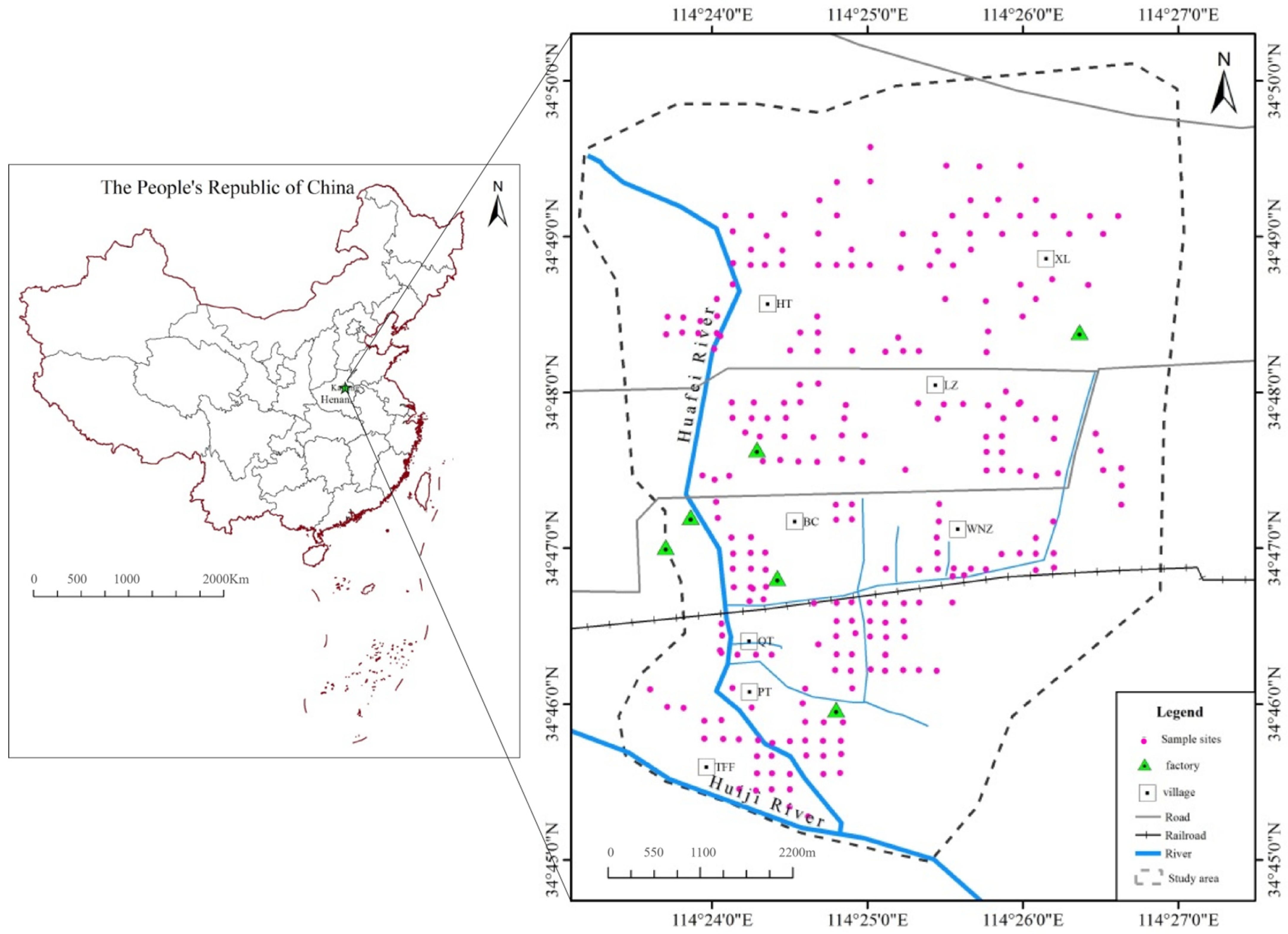
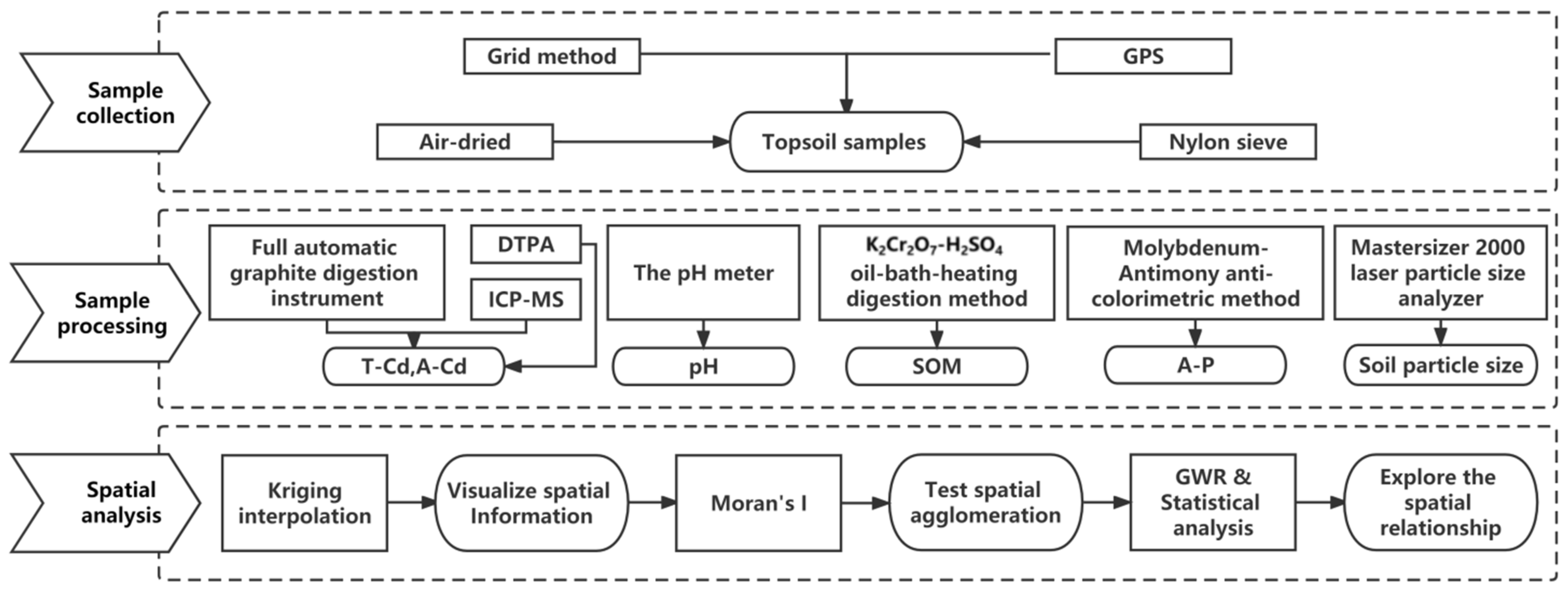

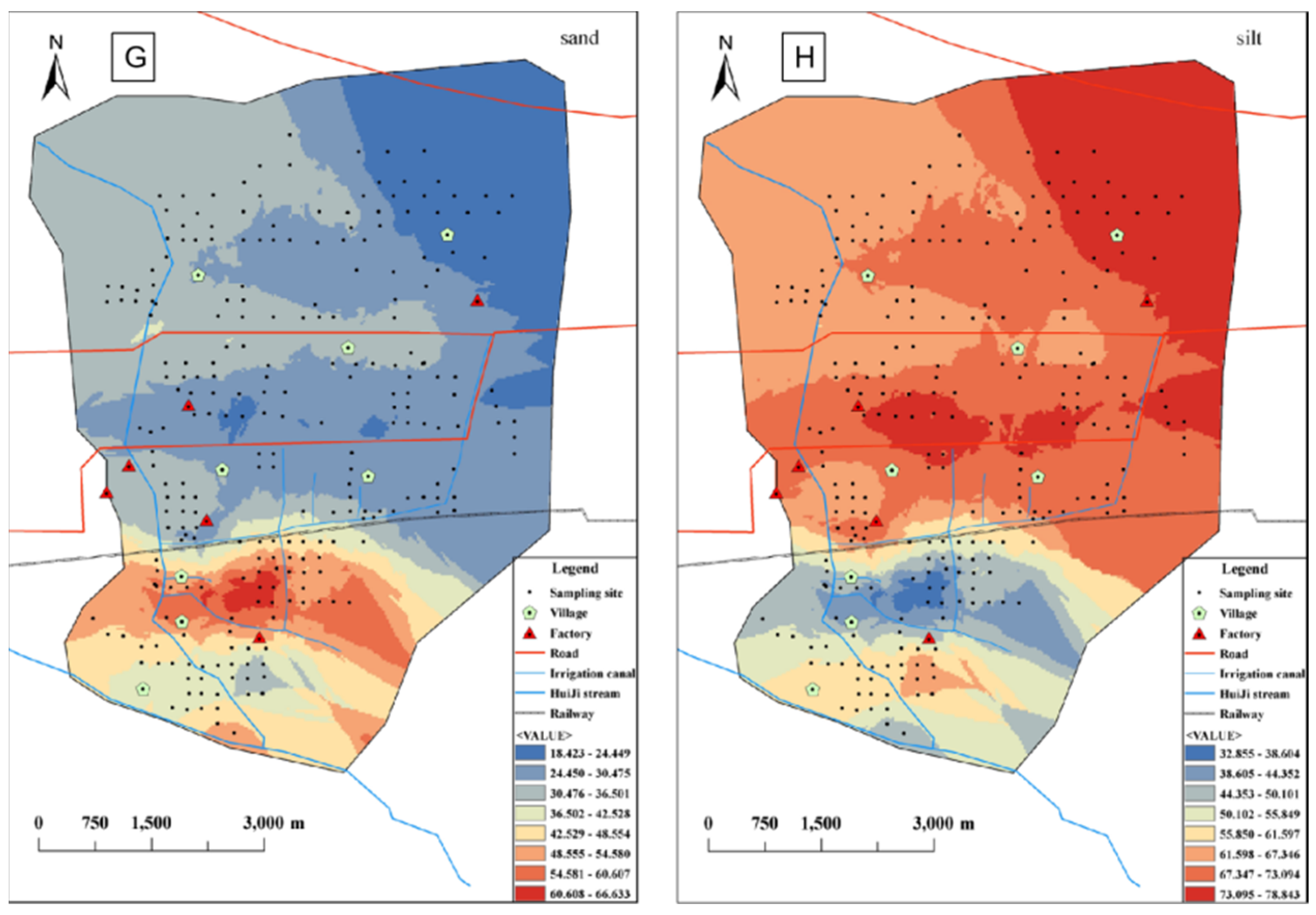
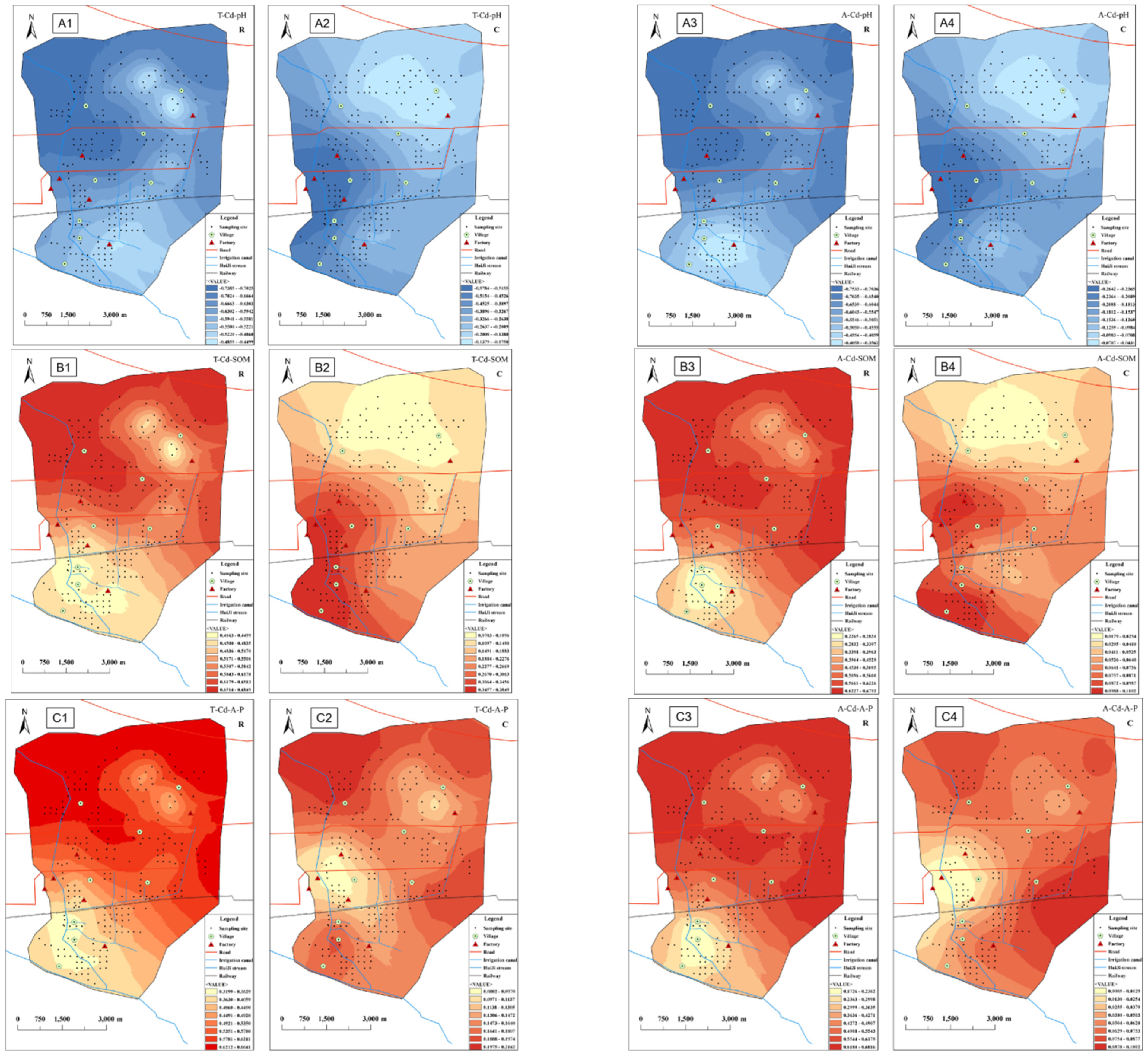
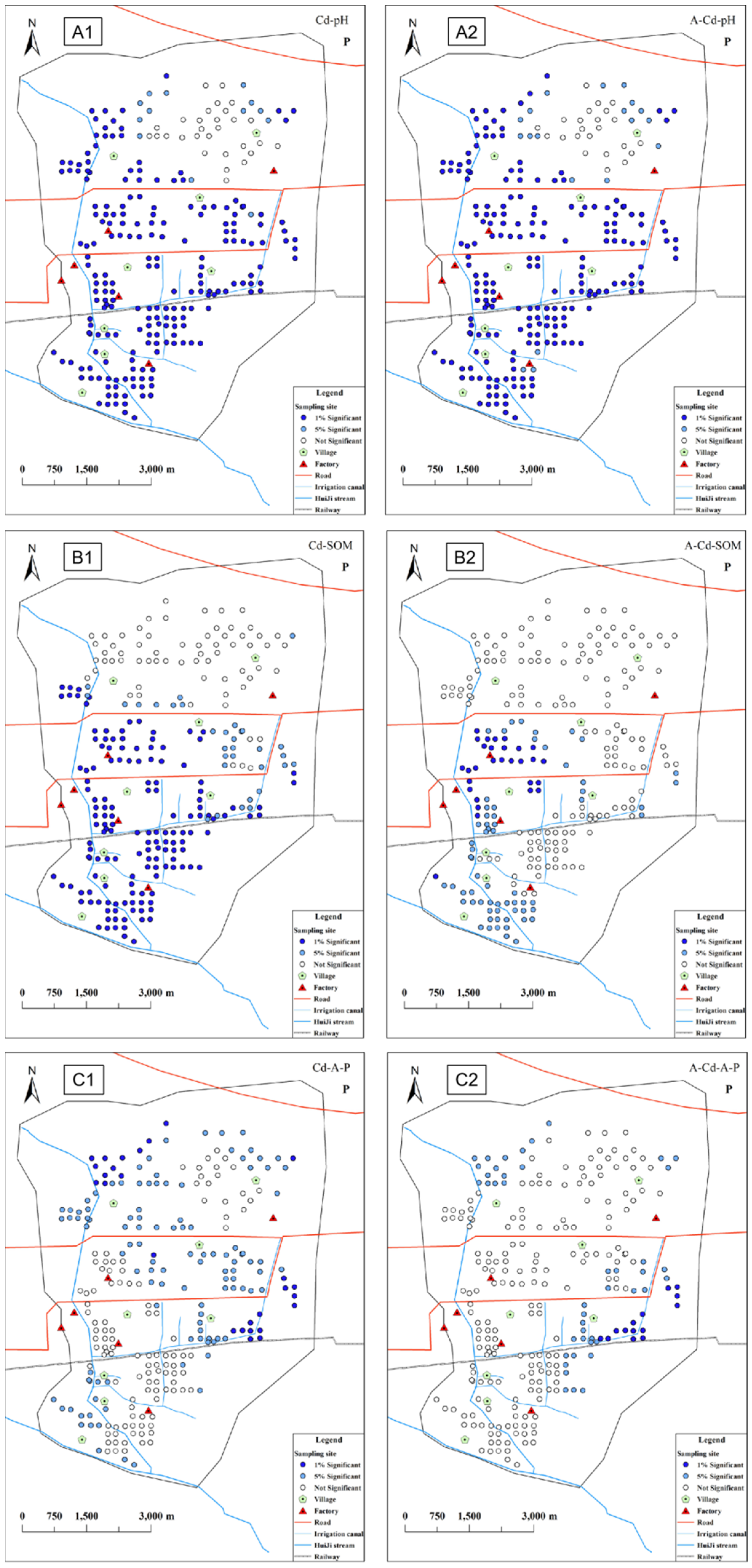
| No. | Variables | Unit | Explanation |
|---|---|---|---|
| 1 | T-Cd | mg kg−1 | The content of total Cd in soil |
| 2 | A-Cd | mg kg−1 | The content of available-Cd in soil |
| 3 | pH | - | Soil pH |
| 4 | SOM | mg kg−1 | Soil organic matter content |
| 5 | A-P | mg kg−1 | Available P content in soil |
| 6 | Clay | % | Clay content in soil |
| 7 | Silt | % | Silt content in soil |
| 8 | Sand | % | Sand content in soil |
| Unit | Min | Max | Mean | SD | Skewness | Kurtosis | CV | |
|---|---|---|---|---|---|---|---|---|
| T-Cd | mg kg−1 | 0.25 | 4.97 | 1.22 | 1.07 | 1.93 | 3.47 | 88.16% |
| A-Cd | mg kg−1 | 0.02 | 2.23 | 0.54 | 0.55 | 1.46 | 1.33 | 101.97% |
| pH | - | 6.82 | 8.96 | 8.05 | 0.27 | −0.41 | 2.80 | 3.38% |
| SOM | g kg−1 | 1.07 | 5.46 | 2.59 | 0.61 | 0.60 | 1.47 | 23.65% |
| A-P | mg kg−1 | 0.44 | 190.50 | 45.06 | 31.87 | 1.86 | 4.59 | 70.72% |
| Clay | % | 0.20 | 12.03 | 1.32 | 0.86 | 8.08 | 96.62 | 65.75% |
| Silt | % | 1.01 | 91.43 | 63.61 | 14.01 | −1.41 | 2.26 | 22.02% |
| Sand | % | 4.06 | 98.79 | 35.08 | 14.35 | 1.39 | 2.24 | 40.92% |
| T-Cd | A-Cd | pH | SOM | A-P | Clay | Silt | Sand | ||
|---|---|---|---|---|---|---|---|---|---|
| T-Cd | correlation | 1.000 | 0.902 | −0.388 | 0.221 | 0.191 | −0.175 | −0.203 | 0.208 |
| significant | 0.000 * | 0.000 * | 0.000 * | 0.003 | 0.006 | 0.001 | 0.001 | ||
| A-Cd | correlation | 0.902 | 1.000 | −0.377 | 0.126 | 0.136 | −0.0224 | −0.365 | 0.370 |
| significant | 0.000 * | 0.000 * | 0.048 | 0.033 | 0.000 * | 0.000 * | 0.000 * |
| Moran’s I | Z Score | p Value | |
|---|---|---|---|
| T-Cd | 0.615415 | 18.88 | 0.000 ** |
| A-Cd | 0.547432 | 16.73 | 0.000 ** |
| SOM | 0.123032 | 3.86 | 0.000114 |
| A-P | 0.201583 | 6.28 | 0.000 ** |
| CaCO3 | 0.669845 | 20.55 | 0.000 ** |
| pH | 0.152657 | 4.77 | 0.000002 |
| Clay | 0.157078 | 6.23 | 0.000 ** |
| Silt | 0.529558 | 16.22 | 0.000 ** |
| Sand | 0.530603 | 16.25 | 0.000 ** |
Publisher’s Note: MDPI stays neutral with regard to jurisdictional claims in published maps and institutional affiliations. |
© 2022 by the authors. Licensee MDPI, Basel, Switzerland. This article is an open access article distributed under the terms and conditions of the Creative Commons Attribution (CC BY) license (https://creativecommons.org/licenses/by/4.0/).
Share and Cite
Chen, Z.; Zhang, S.; Geng, W.; Ding, Y.; Jiang, X. Use of Geographically Weighted Regression (GWR) to Reveal Spatially Varying Relationships between Cd Accumulation and Soil Properties at Field Scale. Land 2022, 11, 635. https://doi.org/10.3390/land11050635
Chen Z, Zhang S, Geng W, Ding Y, Jiang X. Use of Geographically Weighted Regression (GWR) to Reveal Spatially Varying Relationships between Cd Accumulation and Soil Properties at Field Scale. Land. 2022; 11(5):635. https://doi.org/10.3390/land11050635
Chicago/Turabian StyleChen, Zhifan, Sen Zhang, Wencai Geng, Yongfeng Ding, and Xingyuan Jiang. 2022. "Use of Geographically Weighted Regression (GWR) to Reveal Spatially Varying Relationships between Cd Accumulation and Soil Properties at Field Scale" Land 11, no. 5: 635. https://doi.org/10.3390/land11050635
APA StyleChen, Z., Zhang, S., Geng, W., Ding, Y., & Jiang, X. (2022). Use of Geographically Weighted Regression (GWR) to Reveal Spatially Varying Relationships between Cd Accumulation and Soil Properties at Field Scale. Land, 11(5), 635. https://doi.org/10.3390/land11050635






